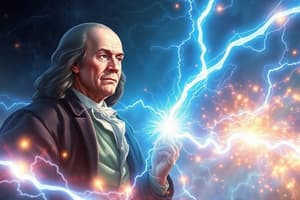Podcast
Questions and Answers
Describe the process of electron flow through friction, explaining how static electricity is built up.
Describe the process of electron flow through friction, explaining how static electricity is built up.
When two materials are rubbed together, electrons are transferred from one material to another, resulting in a buildup of static electricity.
How do photons interact with materials to produce an electric current?
How do photons interact with materials to produce an electric current?
Photons strike the material, causing electrons to be emitted, resulting in an electric current.
Explain how thermal energy leads to the flow of electrons in materials.
Explain how thermal energy leads to the flow of electrons in materials.
Increased temperature causes electrons to gain energy and move more freely, creating an electric current in materials with sufficient conductivity.
In what type of chemical reactions do electrons flow, and what is an example of this process?
In what type of chemical reactions do electrons flow, and what is an example of this process?
Describe the process of electromagnetic induction, and how it leads to the flow of electrons.
Describe the process of electromagnetic induction, and how it leads to the flow of electrons.
What is the primary mechanism by which electric current flowing through a resistor or conductor generates heat?
What is the primary mechanism by which electric current flowing through a resistor or conductor generates heat?
What is the formula for electric power, and what two quantities are multiplied to obtain it?
What is the formula for electric power, and what two quantities are multiplied to obtain it?
What type of devices convert chemical energy into electrical energy during electrochemical reactions?
What type of devices convert chemical energy into electrical energy during electrochemical reactions?
What is the result of passing an electric current through a coil of wire, and what is the resulting device called?
What is the result of passing an electric current through a coil of wire, and what is the resulting device called?
What type of devices convert electrical power into mechanical power, driving various devices such as fans and pumps?
What type of devices convert electrical power into mechanical power, driving various devices such as fans and pumps?
Flashcards are hidden until you start studying
Study Notes
Electron Flow Methods
- Friction (Static Electricity) causes electrons to flow by transferring charges between two rubbed materials, creating a build-up of static electricity.
- Light (Photoelectric Effect) triggers electron flow when photons strike certain materials, emitting electrons and resulting in an electric current.
- Heat increases temperature, causing electrons to gain energy and move freely, generating an electric current in materials with sufficient conductivity.
- Chemistry (Electrochemistry) involves electron flow during chemical reactions that transfer electrons, such as in batteries, where reactions lead to electron movement from one electrode to another.
- Magnetism (Electromagnetism) induces electron flow in response to a changing magnetic field, generating an electric current through electromagnetic induction.
- Pressure (Piezoelectric Effect) causes certain materials to generate electric charge in response to mechanical stress, resulting in electron flow and electric current.
Electricity Conversion
Conversion into Heat
- Electric current flowing through a resistor or conductor with resistance generates heat due to resistance.
- Examples: Electric stoves, toasters, heaters, and incandescent light bulbs convert electrical energy into heat energy.
Conversion into Power
- Electric power is the rate of energy transfer or conversion, calculated as the product of voltage and current (P = VI).
- Example: Electric motors convert electrical power into mechanical power, driving devices such as fans, pumps, and appliances.
Conversion into Electrochemistry (Batteries)
- Electricity is used in electrochemical cells, where chemical reactions involving electron transfer produce electrical energy.
- Example: Batteries convert chemical energy into electrical energy during electrochemical reactions, providing power to electronic devices.
Conversion into Magnetism (Electromagnets)
- Passing an electric current through a coil of wire induces a magnetic field, creating an electromagnet.
- Example: Electromagnets are used in applications such as electric locks, relays, and magnetic resonance imaging (MRI) machines.
Studying That Suits You
Use AI to generate personalized quizzes and flashcards to suit your learning preferences.





